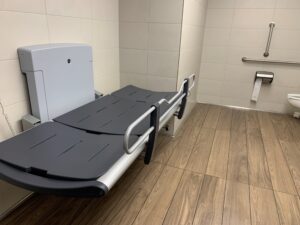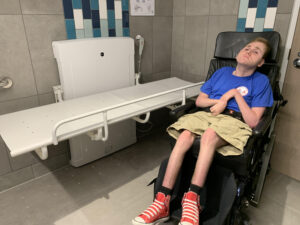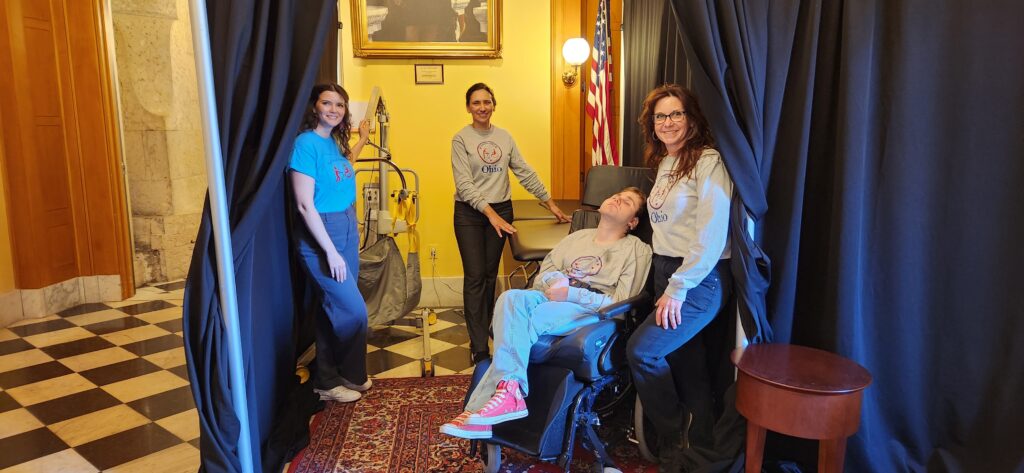
An Inside Look at How Adult Changing Table Advocates are Improving Accessibility, Part 1
Get an inside look at how adult changing tables are becoming part of International Building Code and A117.1.
In Part 1 of our two-part series, the Building Safety Journal takes an inside look at how adult changing tables are being incorporated within the International Building Code® and the A117.1 Accessibility Standard.
The world is gradually becoming a more inclusive place, but there is still work to be done, especially when trying to provide a welcoming environment for those with disabilities. Something as simple as a bathroom break – a task most people take for granted – can become a challenging maneuver that requires assistance.
Providing extra space in restrooms is necessary both for people using wheelchairs and the people providing assistance, but even that is not enough. People with severe disabilities may need an adult-sized changing table.
Jennifer Corcoran, Program Consultant for the Montgomery County Board of Development Disabilities Services (MCBDDS) in Dayton, OH and Co-Lead of Changing Spaces Ohio, has been advocating for change for several years. Her 22-year-old son, Matthew, has special needs and cannot safely and comfortably use the bathroom without adult changing tables. This became especially apparent when he was 14; Corcoran found herself having to change Matthew in the back of her van and on the grass in the park.
“These were very undignified places, as well as unsafe,” she reflected.
This situation inspired Corcoran to take action. She volunteered for Changing Spaces, which advocates for accessible restrooms with adult changing tables. She also co-founded the Inspired Access Foundation, which is raising and providing funds to assist with installing critical equipment (adult changing tables as well as lifts, ramps and more) in public places.
Collaborating With the International Code Council to Improve Accessibility
Hoping for legislative change, Corcoran had three bills in the Ohio senate through former state senator Peggy Lehner and one in the house through former Representative Rick Perales. All four of the bills died, but her last house and senate bills ran concurrently, drawing the attention of the Ohio Building Officials Association (OBOA), a Code Council Chapter for the State of Ohio that consists of 10 component Chapters.
OBOA reached out to Lehner’s office and offered solutions (including assistance in preparing code change submittal) to proposed legislation that would have required universal changing tables to be installed in high-traffic public places. Lehner connected the Code Council with Corcoran, and they’ve been working together ever since.
Corcoran has made a lot of progress with the Code Council in the following years, including her efforts with the ICC A117.1 Adult Changing Facilities Task Group, a sub-committee of the ICC A117.1 Standard Development Committee. As part of the task group, Corcoran helped write the scoping for the 2024 IBC (scheduled to be published later this year) that would determine where adult changing tables would be required.
She also participated in writing the technical specifications, which explain what will be required – the size of the table, height adjustability, etc. – within the A117.1 Accessibility Standard.
Laurel W. Wright, Chair of the ICC A117.1 Adult Changing Facilities Task Group, explained the extensive process the task group went through to develop criteria. Participation included work group members and interested parties with a wide range of interests and included representatives of manufacturers of adult changing tables and parents of adult persons with disabilities that need to use adult changing tables.
The workgroup reviewed eighteen proposed state laws, two already adopted, and four guidelines in European, Australian and North American countries for adult changing tables. While there is interest in many states to provide such facilities, investigations by this workgroup showed either no technical guidance or very inconsistent information and application. The end result currently is limiting access to children with disabilities who have grown up with accessibility in schools and public places, as well as disenabling a significant number of adults with disabilities who have experienced a different type of life-changing event, accidents, injuries or wars.
Adult Changing Tables Serve Everyone Equally
Leaders of governments, municipalities, businesses, educational facilities and other institutions want to make informed decisions regarding adult changing tables. While baby changing tables have been installed for years, they are only able to serve the youngest and smallest members of the population.
“What happens when a child with a disability who requires such a table outgrows its size?” Wright questioned. “Or when an adult who has gone to war, survived a disabling accident or illness and wishes to see their child or grandchild play sports but cannot due to the lack of facilities?”
Without a proper changing table, Wright said that those who need them can either choose to stay home or get changed on the floor of a public restroom, where there is rarely sufficient space. She noted the lack of dignity and privacy, in addition to the fact that the task may also be difficult for the caregiver (such as a spouse who is physically unable to lift the person off the floor) to complete.
If consumers choose the former route and decide to stay home, their economic contributions will be lost in the process.
“While business owners are concerned about the cost of installing an adult changing table, what is often overlooked is the fact that without one, a growing portion of the public is no longer able to contribute to the economy,” Wright explained. “Their buying power is sitting at home, unable to attend movies, go to restaurants, sporting events, shop and do all those everyday things that the rest of us take for granted.”
“The addition of adult changing tables will present a tremendous change in the quality of life for so many people who were unable to get out and participate in many activities before due to the lack of adequate facilities.”
People who choose to stay home may also lose their connections to others.
“The lack of these tables prevents people from participating in the community in a meaningful way,” said Janice Saddler Rice, Director of Communications for Montgomery County Board of Development Disabilities Services. “It’s something that people don’t think about if they don’t have someone with a disability in their life. But it truly is critical.”
Bringing Adult Changing Tables to IBC and A117.1
The task group conducted extensive research to learn more about adult changing tables, their costs, functionality and any laws that have been implemented in the United States or abroad.
For example, California’s AB 662 requires at least one adult changing station to be provided at new (constructed on or after January 1, 2020) or renovated (on or after January 1, 2025) commercial places of public amusement.
“The driving concern is to coordinate requirements between states and eliminate the potential for inconsistencies between differing state requirements,” said Wright.
Task group members were subdivided into five separate sub-groups: Definitions, Scoping, Room Requirements and Venting, Plumbing Fixtures, and Table. According to Wright, each sub-group reviewed the database information specific to their topic and then returned to the overall committee with a summary of findings and a recommendation for the overall task group to discuss.
The committee ultimately determined that adult changing tables should not be required to also serve as bathing facilities, thus making them plumbing fixtures. The washing/rinsing components were not included in their language to avoid provisions that would increase expenses and require extensive considerations for inclusion in the plumbing code.
The task group also determined that the scoping for adult changing tables should be limited to occupancies with a larger occupant load where people would typically plan on spending a significant amount of time to justify the need and cost of installation. For example, an adult changing table would be required in:
- Assembly and mercantile occupancies that are required to have a family or assisted-use toilet or bathing room.
- College and university buildings where 12 or more male and female toilets are required to serve the classrooms and lecture halls.
- Educational facilities with an assembly room or space, such as a high school gym or auditorium, with where a family or assisted-use toilet room is required.
- Highway rest stops and service plazas are located on major highways.
“We need these tables in parks, restaurants, art locations, movie theaters,” Saddler Rice affirmed. “We need them in so many places. They make inclusion possible, not just for people with disabilities and the elderly but also the family and caregivers of these groups. People who have infants can use them as well.”
Stay tuned for Part 2, where we’ll take a look at how states are implementing adult changing tables with grants, legislation and expedited rulemaking.











